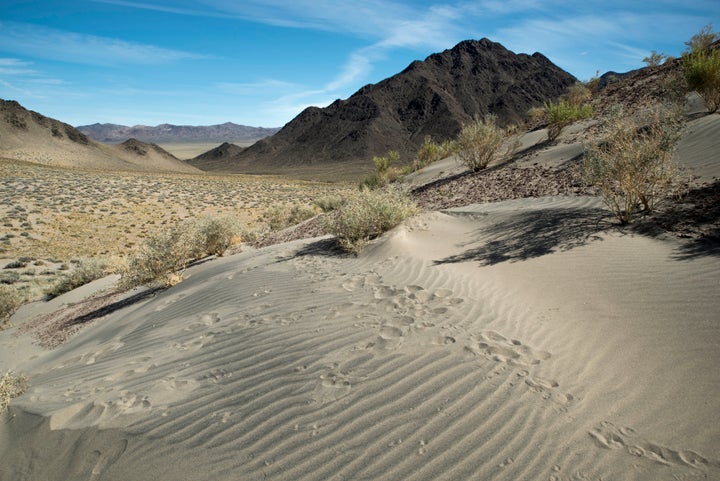
A coalition of four Native American tribes is lobbying for the establishment of a sweeping new national monument surrounding a Navy bombing range in central Nevada in order to permanently protect the area’s cultural and natural resources.
Two leaders of the Fallon Paiute Shoshone Tribe met with senior Biden administration officials and members of Congress this week to pitch their vision for a Numu Newe National Monument spanning nearly 3 million acres of federal lands that are the ancestral home of the Paiute and Shoshone people. “Numu” and “Newe” mean “the people” in the Paiute and Shoshone languages.
Four federally recognized tribes in Nevada — the Fallon Paiute Shoshone Tribe, the Walker River Paiute Tribe, the Lovelock Paiute Tribe and the Yomba Shoshone Tribe — are supporting what would be Nevada’s fifth national monument. The site could be established via either a presidential proclamation or legislation.
The proposed monument would consist of public lands east of Fallon, Nevada, and adjacent to the four tribes’ reservations. It would encompass the Stillwater, Clan Alpine, August and Desatoya mountain ranges, as well as Job Peak, also known as Fox Peak, which is central to the Northern Paiutes’ origin story. The area is already home to several designated wilderness study areas.
The proposed area would be the largest U.S. national monument on land, dwarfing Utah’s 1.87 million-acre Grand Staircase-Escalante National Monument. (The offshore Papahanaumokuakea Marine National Monument is much larger.)
Area tribes, including the Fallon Paiute Shoshone, Walker River Paiute and Yomba Shoshone, have fiercely opposed the Navy’s effort to triple the size of Fallon Naval Air Station’s bombing and training range in the high desert east of Reno. The tribes argue that the planned expansion, currently on hold, would destroy cultural sites and burial grounds, and restrict access for religious ceremonies and other activities.
The tribes see their proposal as a compromise that safeguards their sacred landscapes while allowing for the Navy to continue national security activities on the existing range.
“While the Tribes value a strong military defense, the Navy acknowledges that they have been harmed by Naval Air Station Fallon operations, including the contamination of the Walker River Paiute Tribe’s Reservation, lack of access, constant flyovers, and the bombing of a sacred medicine rock,” reads a summary of the tribes’ proposal shared with HuffPost. “Protecting these lands is a step toward remedying historical wrongs and reducing the environmental justice implications of forcing tribes to bear the disproportionate burden of national defense training.”

Over several days this week, Cathi Tuni-Williams, chair of the Fallon Paiute Shoshone Tribe, and Leanna Hale, the tribe’s director of land and water, and others presented their idea to top officials in the Biden administration, including Navy Secretary Carlos Del Toro and Interior Deputy Secretary Tommy Beaudreau. They also met with members and staff of Nevada’s congressional delegation, including Sen. Jacky Rosen (D) and staff of Rep. Mark Amodei (R). They met with Sen. Catherine Cortez Masto (D) earlier this month.
Tuni-Williams told HuffPost she grew up fishing, hunting deer and rabbit, and gathering pine nuts in the mountains east of her tribe’s reservation. The area, she said, is a place where Paiute and Shoshone people return for retreat, serenity and prayer.
“Our big purpose here is to recognize and honor our heritage and protect what we have left from years of natural resources dwindling, our sacred sites dwindling,” Tuni-Williams said.
Protecting the area is about preserving an identity, Hale said.
“Without these cultural lands, items and way of life, we cease to be numa,” she said, using an alternative Paiute term for “the people.”
The campaign comes as the Biden administration looks to advance its goal of conserving 30% of America’s lands and waters by 2030 as a way to combat the dual climate and extinction crises. But national monuments have become a political lightning rod in recent years, and one as sprawling as what the tribes’ are asking for is sure to attract opponents.
In 2017, then-President Donald Trump carved more than 2 million acres from a pair of national monuments in Utah — Grand Staircase-Escalante and Bears Ears — in what was the largest rollback of federal land protections in U.S. history. But in October, President Joe Biden reversed the Trump-era rollbacks and restored the sites to their original boundaries. Five tribes — the Navajo Nation, the Hopi Tribe, the Ute Mountain Ute Tribe, the Pueblo of Zuni and the Ute Indian Tribe — consider the Bears Ears landscape sacred.
The Nevada tribes now championing the designation of a Numu Newe National Monument say the proposal not only provides an opportunity for the Biden administration to get closer to its “30x30” conservation target, but to fulfill a joint order that Interior Secretary Deb Haaland and Agricultural Secretary Tom Vilsack signed in November 2021. Among other things, the order directed federal agencies to “make agreements with Indian Tribes to collaborate in the co-stewardship of Federal lands and waters.”
While in Congress, Haaland, a member of the Pueblo of Laguna tribe of New Mexico and the first Native American Cabinet secretary in U.S. history, voiced deep concern about the Navy’s bid to expand its bombing range by more than 600,000 acres.
“They’ve lived on the land since time immemorial, their ancestors are buried there,” Haaland told the Reno Gazette Journal in 2020. “The idea this land that is hallowed ground can be used for this type of training, it is really sacrilegious in a way.”
The Interior Department declined to comment on the tribes’ national monument effort.

During a congressional hearing in July, Rosen questioned Del Toro, then Biden’s nominee for Navy secretary, about the Navy’s request for a major expansion. The senator also expressed disappointment that the military branch hadn’t incorporated stakeholders’ suggested changes into its most recent legislative proposal.
“It’s incredibly important to expand that Naval Air Station, as you know, and the range in order to accomplish our national security mission,” Del Toro said. “In doing so, it’s also equally important to respect the tribes that have sacred land there.”
Del Toro’s office did not immediately respond to HuffPost’s request for comment Thursday. Rosen’s office also did not respond. A spokesperson for Cortez Masto confirmed that the senator met with the tribes earlier this month and is currently reviewing the proposal.
Tuni-Williams said the tribes want to be good neighbors and to partner with the Navy, federal land managers and all other stakeholders to steward and manage the landscape. So far, the response to their idea for a monument has been positive, she said.
“I’m really excited and I’m optimistic that we will be able to fulfill this proposal,” she said.
